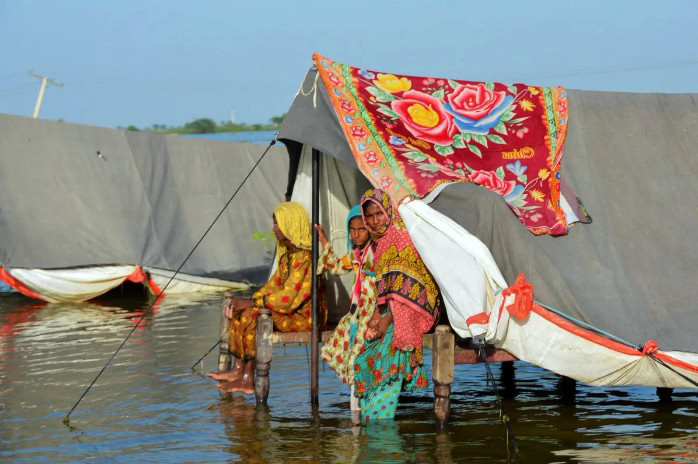
The latest information suggests that economic losses and damages caused by the flash floods could range between $15 billion to $20 billion, as the government fears up to 12 million more people will slip into poverty, underscoring the need for immediate and major global financial assistance.
According to ‘An Early Assessment of Flood Impact on Pakistan’s economy’ report being compiled by the Ministry of Finance, the economic losses are far higher than the initial estimates of $10 billion to $12 billion.
The economic losses have been estimated in the range of $15 billion to $20 billion, according to the preliminary report, indicating huge damages that the country sustained due to flash floods inundating large populations.
There are direct $12 billion losses to the economy, the $6 billion damages to the housing infrastructure and $4 billion was the cost of livestock losses.
Read: UN makes pitch for Pakistan fundraising
Most of the estimates of the economic losses are based on data compiled up to up to September 5, provided by the National Disaster Management Authority (NDMA) but the number is still subject to revision.
“We have updated our earlier estimates of the economic losses to $15 billion to $20 billion in light of new information,” said Dr Aisha Pasha, the Minister of State for Finance who spearheaded the exercise.
The report also showed that the floods could further widen the trade deficit by $4 billion and the additional impact on the current account deficit is also estimated in the range of $4 billion to $5 billion.
Pakistan cannot cope with humongous losses of around $15 billion to $20 billion, which is inclusive of both the direct losses to the economy and loss of the assets, and will require huge global support. Pakistan is victim of the global warming, although its contribution is less than 1%.
'The Early Assessment of Flood Impact on Pakistan’s Economy report is aimed at documenting the losses of economic productivity and damage to public and private infrastructure being assessed by different organisations of the government.
The report says that the government will come up with more firmed-up assessment of damage after a thorough exercise of the damage assessment.
The report further states that 9 million to 12 million more people will fall below the poverty line and one million to two million people have lost their jobs. It added that 77.7% of the informal labour in rural areas constitutes of women, with six out of ten employed young women concentrated in agriculture sector.
Most of the work in agriculture out of need and without a choice, with only 19% in paid employment in agriculture and overall 2.5 times more unpaid work and care than men.
Most of these women have also been care-takers for their livestock and therefore suffering precarious outcomes while trying to save their livestock during the floods, or surviving with the same in challenging living arrangements, according to the assessment.
As against earlier estimates of still achieving over 2% Gross Domestic Product (GDP) growth, the revised estimates give that the growth rate may slip to below 2%. The GDP growth for fiscal year 2022-23 is expected to remain at 1.8% to 2.3%, according to the report.
Read: Mass migration of flood affectees towards Sehwan, Jamshoro begins
The preliminary report showed that the overall loss in the growth of GDP will be 2.8% to 3.3% due to floods.
The initial reports show that as many as 604,212 small businesses have been impacted that are connected to livelihood of 6.55 million people who are without jobs and earning opportunities now. Out of these, the estimates suggest that 282,167 SMEs are in Sindh.
The government has estimated that the trade deficit could further widen by $3 billion to $4 billion due to reduced exports especially cotton and cotton value added. The exports of fruits & vegetables, tobacco, oil-seeds & nuts, meat, tents & canvas, leather & leather footwear, and cement are expected to reduce significantly.
On the other hand, imports of raw cotton, wheat, pulses, sugar, construction machinery, and medicines may increase.
The gross impact on the current account deficit could range from $4 billion to $5 billion but about $1.5 billion impact is expected to be offset due to additional inflows from workers remittances and aid and grants-related inflows.
The government has assessed that it may have to repurpose about 20% of the PSDP or Rs218 billion towards disaster relief expenditure resulting in and additional unemployment of 600,000 due to low spending.
The cotton, rice, maize, and sugarcane are largely affected by the flood and their growth is expected to remain negative by 14% to 15.4%. The growth in other crops is also expected to remain negative by up to 15%.
The growth in livestock is expected to remain 2% to 3%. The loss in growth of the agriculture sector will be 3.5% to 4.5% and its growth may remain negative by up to 2.1% for the current year.
The Food and Agriculture Organization (FAO) early estimates suggest that over 4.5 million acres of crop land have been affected by the recent floods increasing the risk of food insecurity. Only in Sindh 3.5 million acres crops are affected by the floods, causing 78% of the total losses. In Punjab, crops standing at 639,000 acres of land were affected.
The loss in growth of the industrial sector will be 3.5% to 4%. Its growth for the current fiscal year is expected to be 1.9% to 2.5%. The loss in growth of the services sector will be 1.8% to 2.3%. Its growth for FY 2023 is expected to remain at 3.5%.
The Finance Ministry’s preliminary report said that the confirmed deaths due to the floods are more than 1,325 deaths, over 13,000 injured and over 1.7 million houses damaged or destroyed.
The damages to housing infrastructure are estimated at $6 billion. Out of 1.7 million damaged units, as many as 1.5 million are in Sindh, followed by 87,772 in Khyber Pakhtunkhwa and 63,068 in Balochistan. In Punjab 59,000 housing units are estimated to be destroyed by the floods and 1678 in Gilgit Baltistan and Azad Kashmir.
Another $4 billion losses are estimated on account of livestock. The assessment showed that 750,000 livestock have been lost, 5,735 kilometer roads and 246 bridges have been destroyed.
In the power sector, initial estimates show that at least Rs3.3 billion are required to get things operational again, while the true assessment of damage will only be clear once access is restored to all areas. Sindh and Balochistan has faced the most losses. In Sindh, 554 transformers, 486 High tension structure and 47 civil structures destroyed, costing Rs1.6 billion.
As per the NDMA report of 5th, September 2022, the roads infrastructure is blocked due to the floods in Balochistan.
The Railway network across Pakistan is disturbed by the floods, especially the railway track linking Quetta to Taftan in Balochistan and Quetta to Sibbi to Habib Kot from Balochistan to Sindh. The track connecting Punjab to Sindh from Hyderabad to Rohri to Multan is also blocked due to floodwater.
In Sindh, the road from Kotri to Lakhi Shah to Dadu is also disrupted.
The flooding has damaged numerous health facilities across impacted areas, including 501 health facilities in Sindh (including 88 completely), and 244 health facilities in Balochistan.

















1683888120-0/image-(3)1683888120-0-270x192.webp)

















COMMENTS
Comments are moderated and generally will be posted if they are on-topic and not abusive.
For more information, please see our Comments FAQ